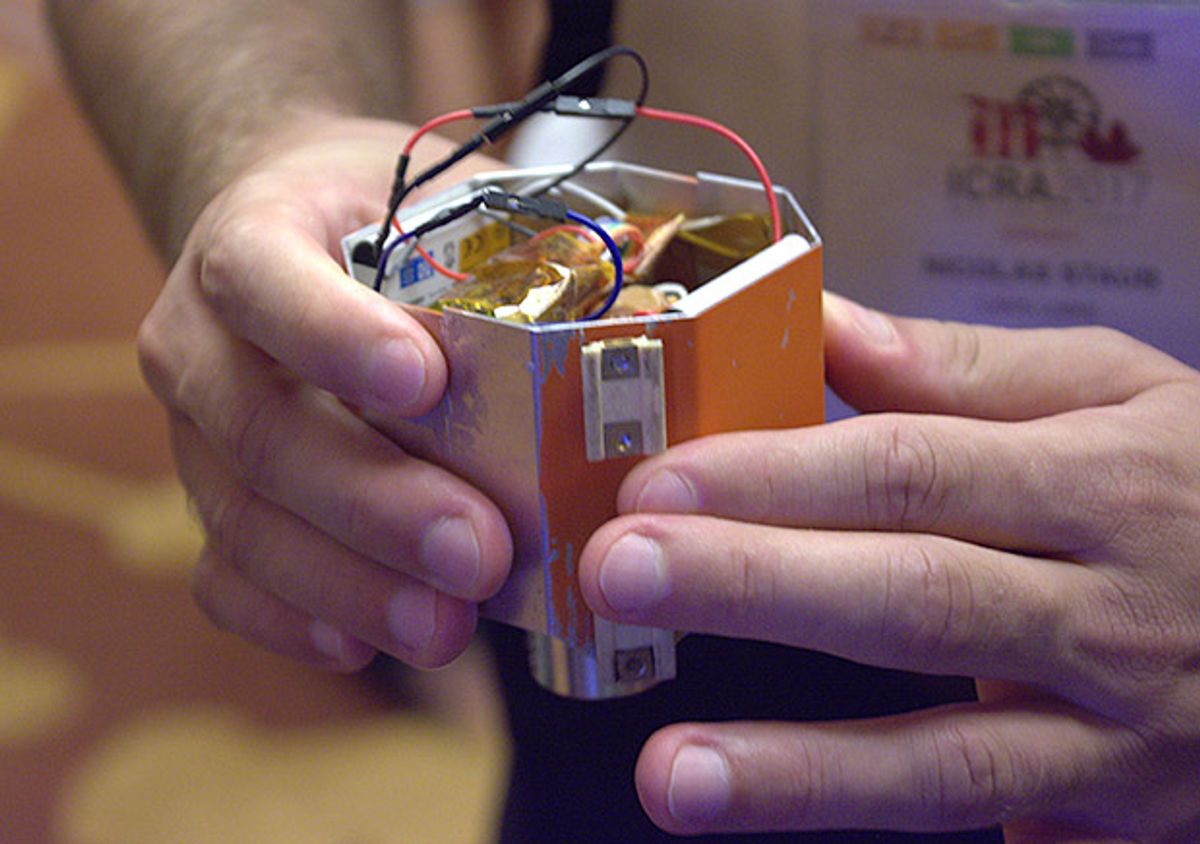In terms of overall bang for your buck, solid-fuel rockets are pretty great: They’re dead simple, very reliable, and offer respectable efficiency in a very small form factor, as long as you’re prepared to handle a lot of thrust all at once and then never again. While some robots have attempted to use rockets to jump from place to place, controllability has always been an issue, since solid-fuel rockets give you a fixed amount of thrust whether you want it or not, and that thrust isn't always directed in exactly the way you'd like.
At ICRA last week, researchers from the Japan Aerospace Exploration Agency (JAXA) introduced a small robotic explorer that uses a single solid-fuel rocket to launch itself into the air. What’s new is that their robot includes some braking rockets that help it make pinpoint landings, as well as a clever gyroscopic system to make sure that it flies straight as well as providing a way for the robot to get around after landing.
The 450-gram robot consists of a housing with batteries and sensors, a reaction wheel (also inside the housing), a primary solid-fuel rocket engine (an Estes C11 with a total impulse of 10 newton-seconds), and two smaller opposing thrust motors. The robot is mounted on an angled rail and when it’s time to fly, it spins up its reaction wheel and sets off the primary rocket. The rocket launches the robot on a parabolic trajectory with a maximum range, in Earth gravity, of up to about 30 meters, which would increase to about 200 meters under lunar gravity.

The reaction wheel minimizes the effect of the robot body tumbling during flight, keeping the robot going on a straight line: We held this little thing with the gyro wheel turned on during an interactive session at ICRA, and it was impressively powerful: There was a significant amount of resistance to any kind of sideways rotation. Since solid-fuel rocket engines can’t be throttled, the opposing thrust motors are fired when necessary to alter the robot’s trajectory for a targeted landing. It’s a fairly effective technique, and in their tests the standard deviation of a series of launches decreased from 1.2 to 0.29 meters, or four times more precise than without the opposing rockets.
The obvious downside with a robot like this is its lack of reusability: With just one primary motor, you’re getting one big jump and no more. But, the argument is that you’re instead getting a system with a very high efficiency: small size and weight coupled with a very long range. You might decide to bring a bunch of these little rocket explorers along on a rover mothership, rather than a single larger system that’s reusable, but has shorter range and is more complex (and consequently less reliable) to operate.
A prospective scenario is described as follows. The rocket-propelled miniature robot is loaded onto a planetary lander or possibly rover. The mothership arrives near the target site, but the mothership cannot reach the target site. While the operator has knowledge of the direction and distance to the target site, he/she adjusts the heading and elevation of the robot launcher rail at the top of the mothership. The elevation angle of the rail is settled such that the rocket-propelled robot can reach the target point with least expected thrust impulse of the main engine. After turning-on the reaction wheel, the main engine is ignited. As the robot flies, the pose and position is estimated by inertial navigation. In order to cancel the exceeded distance, the opposing jet is ignited at an appropriate instance. It lands at the goal and landing impact absorption reduces the shock to the robot.
Once all the rocketing is done, the robot still has a mobility trick up its sleeve: By spinning up its reaction wheel and braking it, it can hurl itself forwards or backwards (a trick we’ve seen other robots, like the MIT M-Blocks, doing). It’s perhaps not the most controllable method of locomotion, but for planetary exploration, the advantage is that it’s a closed system, which can be sealed against dust.
This version of the robot doesn’t have any built-in impact absorption, and it also doesn’t have a rotating outer casing that would be able to provide panoramic camera images in-flight. There also has to be some thought towards scientific instruments that are small enough to cram in there. What seems most interesting is the potential for robots like these (or perhaps much smaller versions) to operate in very low gravity environments like asteroids and small moons, where rockets may be the best (or only) way of getting around.
“Distance Control of Rocket-propelled Miniature Exploration Robot,” by Hiroki Kato, Nobutaka Tanishima, Keiichi Yanagase, Toshimichi Tsumaki, and Shinji Mitani from the Japan Aerospace Exploration Agency (JAXA), was presented at ICRA 2017 in Singapore.
Evan Ackerman is a senior editor at IEEE Spectrum. Since 2007, he has written over 6,000 articles on robotics and technology. He has a degree in Martian geology and is excellent at playing bagpipes.



